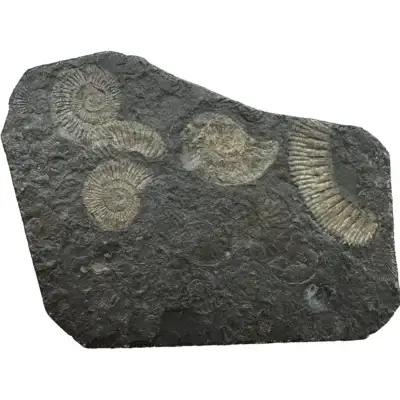Stunning German Pyrite Ammonites
Showing all 2 results
German ammonites are exceptional fossils known for their outstanding preservation and striking beauty, making them highly sought after by collectors and paleontologists. These ancient marine creatures, which lived millions of years ago during the Mesozoic Era, are often found in regions of Germany, particularly in areas like Bavaria and the Swabian Jura. German ammonites are prized for their well-defined, spiral-shaped shells and intricate fossil details, often showcasing vibrant patterns and fine texture. They provide a rare glimpse into the biodiversity of ancient seas, making them a valuable addition to any fossil collection.
Available in various sizes and price ranges, German ammonites can be found starting at affordable prices for smaller specimens, while larger, more intricate pieces can command higher prices due to their exceptional quality and rarity. Known for their authenticity and geological significance, these ammonite fossils offer collectors a chance to own genuine pieces of Earth’s ancient marine life. Whether you’re an experienced collector or a beginner, German ammonites are a fantastic way to learn about prehistoric marine ecosystems and add a unique, historical treasure to your fossil collection.
Ammonites from Germany
1. What is an ammonite?
Ammonites are extinct marine mollusks that lived during the Mesozoic Era, known for their coiled, spiral shells. These ancient creatures are related to modern cephalopods like squids and octopuses, but they had hard, protective shells. German ammonites are particularly famous for their well-preserved fossils, which are often found in the country’s rich geological layers. Fossils of ammonites from Germany offer significant insights into the marine ecosystems of the past, and they have been a valuable resource for paleontologists and collectors alike. The ammonites of Germany, often with intricate shell patterns, are considered a treasure in fossil hunting.
2. How old are German ammonites?
The ammonites found in Germany are primarily from the Jurassic and Cretaceous periods, which spanned from about 201 to 66 million years ago. These time periods saw the peak of ammonite diversity, and German fossil sites have yielded ammonite fossils from both of these eras. The famous Solnhofen limestone formation in Bavaria, for example, contains ammonite fossils dating back to the late Jurassic, approximately 150 million years ago. The fossils in Germany’s various sedimentary layers provide a snapshot of the ancient seas that once covered much of the region.
3. Where are ammonites found in Germany?
Germany is home to some of the most famous fossil sites for ammonites, especially in regions like Bavaria, Swabia, and the Franconian Jura. The Solnhofen limestone formation in Bavaria is one of the most renowned fossil beds in the world, known for its exceptional preservation of ammonites, as well as other prehistoric life forms. Ammonites can also be found in other parts of Germany, such as the Swabian Jura, and in areas like the Harz Mountains. These regions have rich deposits of sedimentary rock, particularly limestone and shale, where ammonite fossils are commonly found.
4. How many species of ammonites are there in Germany?
Germany has yielded a wide variety of ammonite species, with over 500 different species identified across the country. These species belong to various genera, including Acanthoceras, Dactylioceras, Turrilites, and Perisphinctes. The diversity of species found in Germany reflects the range of environments in which ammonites lived, from shallow coastal seas to deeper oceanic waters. The large number of species found in German fossil sites makes the region an important area for understanding the evolution and diversity of ammonites during the Mesozoic Era.
5. How big did ammonites get in Germany?
Ammonites found in Germany could grow to impressive sizes, with some species reaching diameters of over 1 meter (3.3 feet). The largest ammonites from Germany belong to the genus Turrilites, which is known for its large, tightly coiled shells. These giant ammonites would have been among the most remarkable marine creatures of their time. While most ammonites found in Germany are smaller, typically ranging from a few centimeters to about 30 cm (1 foot) in diameter, the larger specimens are prized for their size and well-preserved fossilization. The size and quality of ammonite fossils found in Germany make it one of the leading countries for the study of these ancient sea creatures.
Prehistoric 101 (Learn about fossils, minerals, and meteorites)
Learn: Ammonites
Ammonites: The Spirals of Time
Prehistoriclearn.com



